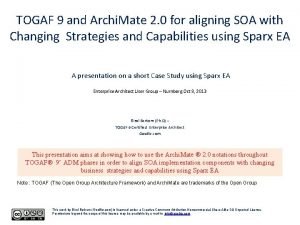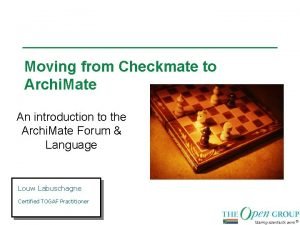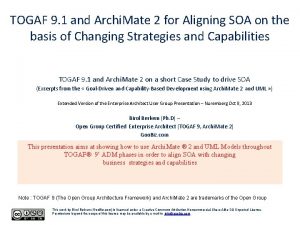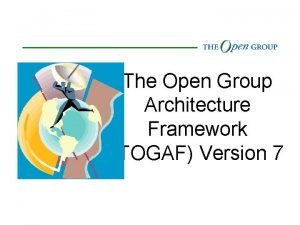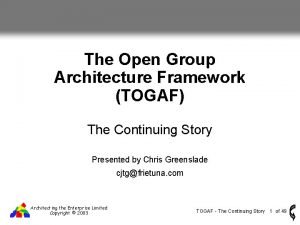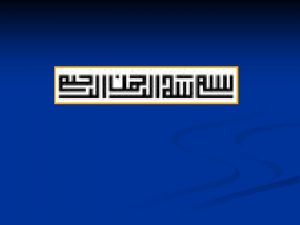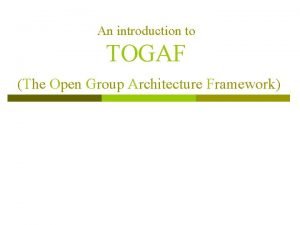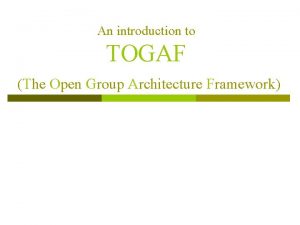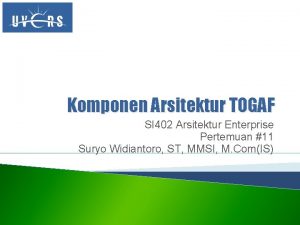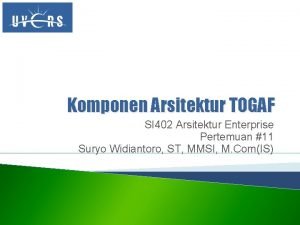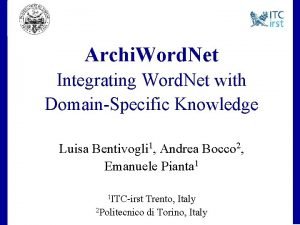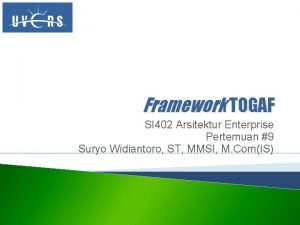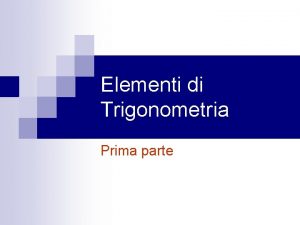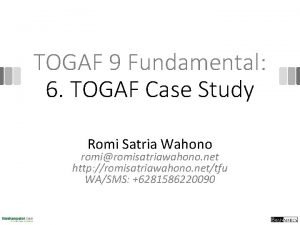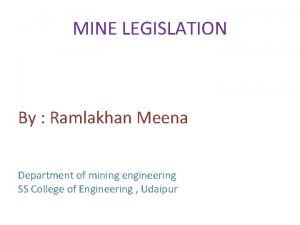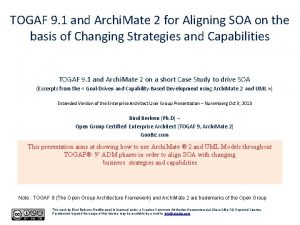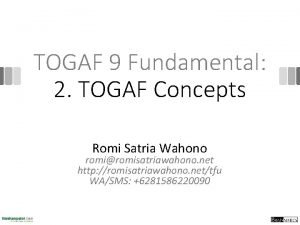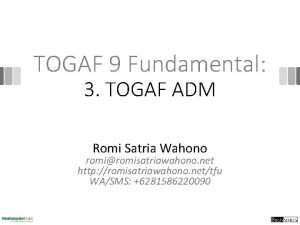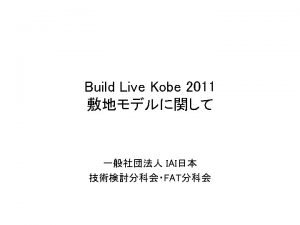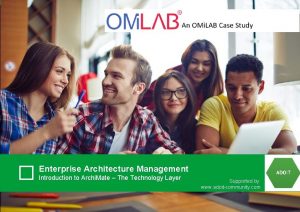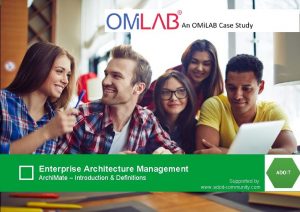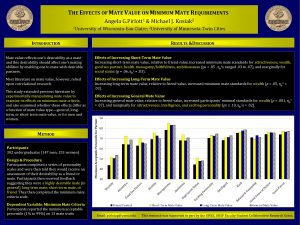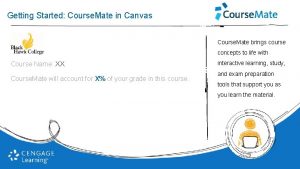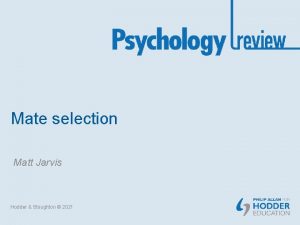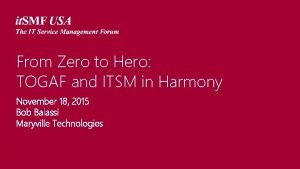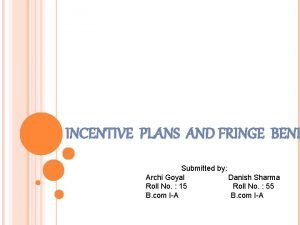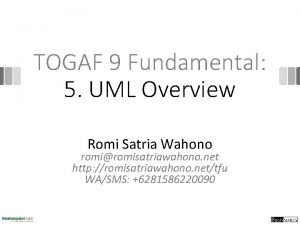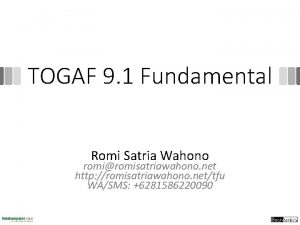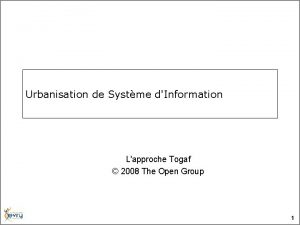TOGAF 9 1 and Archi Mate 2 for














































- Slides: 46

TOGAF 9. 1 and Archi. Mate 2 for Aligning SOA on the basis of Changing Strategies and Capabilities TOGAF 9. 1 and Archi. Mate 2 on a short Case Study to drive SOA (Excerpts from the « Goal-Driven and Capability-Based Development using Archi. Mate 2 and UML » ) Extended Version of the Enterprise Architect User Group Presentation – Nuremberg Oct 8, 2013 Birol Berkem (Ph. D) – Open Group Certified Enterprise Architect (TOGAF 9, Archi. Mate 2) Goo. Biz. com This presentation aims at showing how to use Archi. Mate ® 2 and UML Models throughout TOGAF® 9’ ADM phases in order to align SOA with changing business strategies and capabilities Note : TOGAF 9 (The Open Group Architecture Framework) and Archi. Mate 2 are trademarks of the Open Group This work by Birol Berkem (Goo. Biz. com) is licensed under a Creative Commons Attribution-Noncommercial-Share Alike 3. 0 Unported License. Permissions beyond the scope of this license may be available by e-mail to info@goobiz. com

Structure of this Presentation • Business Agility – Definitions • Enterprise Architecture : Goals and Roles • Balanced Score. Cards / Strategy Map techniques to specify Governance Aspects of the EA Operating Model • Business & IT Alignment using TOGAF 9. 1 and Archi. Mate 2 – – – – – Phases in TOGAF’s ADM – A Summary TOGAF for SOA - Initial Content Meta-Model TOGAF’s Capability-Based Planning and Archi. Mate 2 Layers Modeling with Archi. Mate 2 throughout TOGAF 9. 1’ ADM phases Structuring Capabilities to track risk mitigation by function, adapt them to changing requirements and align related SOA process components Updating the Architecture Repository Performing Impact Analysis of Business Capabilities upon the Application and Technology layers Modeling the Roadmap, Transition Architectures and Work Packages Modeling Implementation Projects Planning The SOA Architectural Backbone at the Implementation Governance Phase • Conclusion 2

Business Agility : Definitions • Business agility is the ability of a business to adapt rapidly and cost efficiently in response to changes in the business environment. • Business agility can be maintained by adapting goods and services to meet customer demands, adjusting to the changes in a business environment and taking advantage of assets (organization, person, process, technology). • Adapted from "On the Measurement of Enterprise Agility". Journal of Intelligent and Robotic Systems 33 (3): 329– 342. DOI: 10. 1023/A: 1015096909316 Nikos C. Tsourveloudi , Kimon P. Valavanis (2002) 3

Business Agility : The needs ! • The alignment of organizations with the changing needs of their customers and environment requires: – Architecting business and IT resources of the extended enterprise to ensure a value-driven solution to these needs and capitalize on these structures in face of changes, – Communicating key requirements, principles and models of the future state of the enterprise (vision, goals, strategies, …) until the IT level to ensure a coherent evolution, • Such an alignment makes necessary building an architecture framework that includes : – users, processes, information and technology, but also their internal and external relationships with their environment 4

What methodologies, architectures and specification languages to ensure a business agility ? What are the roles of the EA in capitalizing on the business knowledge and aligning IT with the changing strategies ? 5

Enterprise Architectures : Goals and Roles ! • Enterprise Architecture enables effective execution of the enterprise strategy to achieve change of an organization ! • Enterprise Architecture is usualy done to identify gaps between current and target architecture state of an organisation. • It provides roadmap to achieve goals and deliver objectives to ‘guide’ current and future projects of the organisation. • TOGAF 9 ® : An Enterprise Architecture Framework proposed by the Open Group to align Enterprise Ressources, IT Systems and Technologies with the changing Business Strategies and Business Capabilities. What are the phases of TOGAF’s Architecture Development Method (ADM) to 6 ensure these goals and roles ?

Phases in TOGAF’s ADM – A Summary Governance of implementation and Architecture Change Management Architecture Planning : Business Drivers and Goals Concerns of Stakeholders, Principles, Requirements, Capability Assesment, Business Transformation Readiness Factors, … Development of the Enterprise Architecture, Views of the Architecture across domains, Risk Mitigation , … Detailed Implementation and Migration Plan Work Packages and Transition Architectures Consolidating architecture descriptions Definition of the Roadmap Identifying opportunities for re-use and potential solution components What sources to provide ‘business inputs’ for the Governance Aspects of an EA ? 7

Use ‘Balanced Score. Cards (BSC)’ / ‘Strategy Map’ techniques to specify Governance Perspectives for the EA Operating Model “What we do have to improve…" Shareholder requests Branding displayed to customers Tactical and process level KPIs to specify here… “What we have to do to enhance “value creation” How to implement such governance perspectives along the phases of TOGAF 9 ? © Birol Berkem Goo. Biz 2014 8

Governance Perspectives of the BSC can be realized throughout Business, IS and Technology Capabilities using ADM Business agility is the ability of a business to adapt rapidly and cost efficiently in response to changes in the business environment. How to implement actions that are part of the BSC Perspectives and monitor risks ? Drivers and Goals to support the BSC’s Financial & Customer Perspectives ? Activities and processes to support the BSC’s Business Process and Resource Perspectives ? What systems will allow efficient execution of these processes in order to support related Perspectives ? How to ensure integration and coherence of the B, C, D phase outcomes and find solutions during transformation programs ? What technical infrastructures will allow availability and security of the IT systems ? How to adapt business, IS and Technology Architecture Capabilities using such governance perspectives to increase business agility ? 9 © Birol Berkem Goo. Biz 2014

Use Archi. Mate 2 for the Business & IT Alignment – Archi. Mate is a modeling language for describing enterprise architectures – Broader scope than UML (essentially designed for software engineering) – Supports EA frameworks like TOGAF 9 & Zachman – Archi. Mate 2 adds value to TOGAF 9. 1 by bringing consistency, traceability, completeness ! – Archi. Mate viewpoints are more detailed than TOGAF’s architecture artifacts – TOGAF does not provide a specification 10 language for descriptions and examples © Birol Berkem Goo. Biz 2014

Driving IT/SOA on the basis of Changing Strategies and Capabilities – Part I • Business Agility & Enterprise Architecture : Goals and Roles • Balanced Score. Cards / Strategy Map techniques to specify Governance Aspects of the EA Operating Model • Business & IT Alignment using TOGAF 9. 1 and Archi. Mate 2 – – – Phases in TOGAF’s ADM – A Summary TOGAF for SOA - Initial Content Meta-Model & TOGAF’s Capability-Based Planning and Archi. Mate 2 Layers Modeling with Archi. Mate 2 throughout TOGAF 9. 1’ ADM phases Structuring Capabilities to track risk mitigation by function, adapt them to changing requirements and align related SOA process components Performing Impact Analysis of Business Capabilities upon the Application and Technology layers Updating the Architecture Repository Modeling the Roadmap, Transition Architectures and Work Packages ‘Coordinate’ Implementation Projects Planning on the basis of Architecture constraints Structuring the Goal-Driven and Capability Based SOA Backbone at the Implementation Governance Phase Plug-in solution building-blocks (components) to achieve service behaviors with expected service levels … 11 • Conclusion © Birol Berkem Goo. Biz 2014

Business & IT Alignment using TOGAF ® 9 / SOA Capabilities are abilities of the Organization that require a combination of Organization, People, Processes and Technology to achieve (TOGAF 9. 1 Definition) Capabilities are delivered by Functions that are accessed thru governed Interfaces provided by Business Services Drivers and Goals drive Capabilities Parameters are considered to control execution of processes that orchestrate functions to deliver Capabilities Application, Data and Technology layer components support Business Services that allow access to Business functions to deliver Capabilities Q : So, how to link such concepts to increase business agility ? A 1 : Need a ‘Goal driven and Capability-Based’ methodology to adapt SOA implementation components to changes A 2 : Need also a language to ensure coherence, completeness and traceability to support this continuous adaptation 12 © Birol Berkem Goo. Biz 2014 The Content Meta. Model from the Open Group’s TOGAF ® 9. 1 Specifications

Use the TOGAF’s « Capability-Based Planning » with Archi. Mate 2 Goals and Objectives are initially fixed in the Preliminary and Architecture Vision Phases Capabilities are structured to mitigate Risks upon their internal functions, also to make impact analysis throughout IS and Technology layers • Incremental Road. Map to reach the Target Architecture by reusing existing capabilities • Work Packages of Actions to implement these Increments as well as to ‘coordinate’ Implementation Projects Capability Based Planning from the Open Group’s TOGAF ® 9. 1 Archi. Mate 2 adds value to TOGAF 9. 1 by bringing consistency, completeness and traceability to support this Goal-Driven and Capability-Based continuous adaptation! Capability-Based SOA Backbone where solution components plugged into the architecture ones are orchestrated to realize related functions… (also by guiding application projects upon the enterprise architecture decisions) 13 How can this Goal & Capability-Driven Approach be realized by the Open Group’s Archi. Mate 2 Concepts and Relationships ? From the Open Group’s Archi. Mate ® 2 Specifications © Birol Berkem Goo. Biz 2014

Basic Archi. Mate Concepts (Simplified !) Archi. Mate 2 brings BIZ. FUNCTION consistency (well established notation with unambiguous relationship types), completeness (explicit modelling of requirements, principles, constraints, work packages, transition architectures), traceability (relationships to architecture components using views across multipledomains). 14 Simplified Archi. Mate Elements adapted from « EA Modeling with Archi. Mate & Sparx » - A. Sikandar Cap Gemini Canada

Archi. Mate 2 – Some Important Viewpoints useful for the Concern of IT / Business Alignment Application Usage Viewpoint Introductory Viewpoint Infrastructure Viewpoint Organization Viewpoint Infrastructure Usage Viewpoint Actor Co-Operation Viewpoint Implementation and Deployment Stakeholder Viewpoint Goal Realization Viewpoint Information Structure Viewpoint Goal-Contribution Viewpoint Project Viewpoint Principle Viewpoint Service Realization Viewpoint Requirement Realization Viewpoint Layered Viewpoint Motivation Viewpoint Landscape Map Viewpoint Business Function Viewpoint Migration Viewpoint Business Process Viewpoint Implementation and Migration Business Process Co-operation Viewpoint Product Viewpoint Application Behavior Viewpoint A viewpoint in Archi. Mate is a selection of a relevant subset of the Archi. Mate concepts and the representation of that part Application Co-operation Viewpoint of an architecture Application Structure Viewpoint 15 Application Usage Viewpoint On the basis of the previous Balanced Score Card example input data, © Birol Berkem let us use some of these viewpoints within EA Goo. Biz 2014

Driving SOA on the basis of Changing Strategies and Capabilities – Part II • Business Agility & Enterprise Architecture : Goals and Roles • Balanced Score. Cards / Strategy Map techniques to specify Governance Aspects of the EA Operating Model • Business & IT Alignment using TOGAF 9. 1 and Archi. Mate 2 – – – Phases in TOGAF’s ADM – A Summary TOGAF for SOA - Initial Content Meta-Model TOGAF’s Capability-Based Planning and Archi. Mate 2 Layers Modeling with Archi. Mate 2 throughout TOGAF 9. 1’ ADM phases Structuring Capabilities to track risk mitigation by function, adapt them to changing requirements and align related SOA process components Updating the Architecture Repository Performing Impact Analysis of Business Capabilities upon the Application and Technology layers Modeling the Roadmap, Transition Architectures and Work Packages ‘Coordinate’ Implementation Projects Planning on the basis of Architecture constraints Structuring the Goal-Driven and Capability Based SOA Backbone at the Implementation Governance Phase Plug-in solution building-blocks (components) to achieve service behaviors with expected service levels … 16 • Conclusion © Birol Berkem Goo. Biz 2014

Reminder : The ‘Balanced Score. Cards (BSC) Governance Perspectives for the EA Operating Model “What we do have to improve…" Shareholder requests Branding displayed to customers Tactical and process level KPIs to specify here… (cf. the Content of the Architecture Repository in Part III) “What we have to do to enhance “value creation” How to implement such governance perspectives along the phases of TOGAF 9 ? 17 © Birol Berkem Goo. Biz 2014

In the Preliminary Phase of TOGAF 9 : We start by modeling Baseline Architecture Capabilities of the Web Sale Company 18 How to adapt and structure these capabilities using a « Capability-Based Planning » ? © Birol Berkem Goo. Biz 2014

Reminder : TOGAF’s ADM Phase Objectives and the « Capability-Based Planning » to align EA with Business Goals and Capabilities Governance of implementation and Architecture Change Management Detailed Implementation and Migration Plan Work Packages and Transition Architectures Architecture Planning : Business Drivers and Goals Concerns of the Stakeholders Principles, Requirements, Capability Assesment, Readiness Factors, … Development of the Enterprise Architecture, Views of the Architecture across domains, Risk Mitigation , … Consolidating architecture descriptions Definition of the Roadmap Identifying opportunities for re-use and potential solution components Let’s start by considering Goals and Objectives Initially provided as part of the BSC Financial and Customer perspectives within the ADM Preliminary & the Architecture Vision Phases 19 From the Open Group’s TOGAF ® 9. 1 Specifications © Birol Berkem Goo. Biz 2014

In the Preliminary Phase : Drivers, Assessments and Initial Goals of the EA may be modeled using the Archi. Mate ‘Stakeholder Viewpoint’ Business Drivers, Goals Principles, initial Requirements, … How to discover Requirements on the basis of Stakeholders, Drivers and Goals ? 20 20 © Birol Berkem Goo. Biz 2014

In Phase A : Requirements can be discovered by decomposing Goals using the Archi. Mate ‘Goal Realization’ and ‘Motivation ‘Viewpoints 21 How to initiate ‘Capability Assessment’ on the basis of Changing Strategies and Maturity Level ? © Birol Berkem Goo. Biz 2014

‘Capability Assessment’ may be initiated by assigning appropriate responsibilities to Capabilities on the basis of Changing Strategies Now, how to make impact analysis of changing strategies assigned to each capability to ensure coherent deployment of the Target Architecture ? How to manage the performance level of target capabilities and adapt them to changes ? 22 Sub-Capabilities and their functions to deliver each of these Targeted Capabilities on the basis of strategies may be precisely discovered using Archi. Mate Viewpoints (next slides) © Birol Berkem Goo. Biz. com Paris, 2015

In Phase A : Business Functions can also be discovered by applying the Archi. Mate ‘Goal Realization’ and ‘Motivation ‘Viewpoints (2/2) 23 How to structure these Capabilities until the Technology Layer to mitigate risks, adapt them to changing © Birol Berkem requirements and align related SOA process components ? Goo. Biz 2014

Driving IT/SOA on the basis of Changing Strategies and Capabilities – Part III • Business Agility & Enterprise Architecture : Goals and Roles • Balanced Score. Cards / Strategy Map techniques to specify Governance Aspects of the EA Operating Model • Business & IT Alignment using TOGAF 9. 1 and Archi. Mate 2 – – – Phases in TOGAF’s ADM – A Summary TOGAF for SOA - Initial Content Meta-Model TOGAF’s Capability-Based Planning and Archi. Mate 2 Layers Modeling with Archi. Mate 2 throughout TOGAF 9. 1’ ADM phases Structuring Capabilities to track risk mitigation by function, adapt them to changing requirements and align related SOA process components Updating the Architecture Repository Performing Impact Analysis of Business Capabilities upon the Application and Technology layers Modeling the Roadmap, Transition Architectures and Work Packages ‘Coordinate’ Implementation Projects Planning on the basis of Architecture constraints Structuring the Goal-Driven and Capability Based SOA Backbone at the Implementation Governance Phase Plug-in solution building-blocks (components) to achieve service behaviors with expected service levels … • Conclusion 24 © Birol Berkem Goo. Biz 2014

Structure capabilities until the Technology Layer on the basis of requirements and risks & align related SOA Processes • Business Agility – Definitions • • Enterprise Architecture : Goals and Roles Balanced Score. Cards / Strategy Map techniques to specify Governance Aspects of the EA Operating Model • Business & IT Alignment using TOGAF 9. 1 and Archi. Mate 2 – – – • Phases in TOGAF’s ADM – A Summary TOGAF for SOA - Initial Content Meta-Model Basic Concepts, Layers and Viewpoints in Archi. Mate 2 Modeling with Archi. Mate 2 throughout TOGAF 9. 1’ ADM phases Structuring Capabilities to mitigate risks, adapt them to changing requirements and align related SOA components Performing Impact Analysis of Business Capabilities upon the Application and Technology layers Updating the Architecture Repository Modeling the Roadmap, Transition Architectures and Work Packages Modeling Implementation Projects Planning Structuring the Goal-Driven and Capability Based SOA Backbone at the Implementation Governance Phase Plug-in solution building-blocks (components) to achieve service behaviors with expected levels … Conclusion Let’s continue by structuring Capabilities to mitigate risks upon functions that compose them and also to analyze impacts of their evolution throughout Application and Technology layers 25 © Birol Berkem Goo. Biz 2014

Phase A: Excerpt from the « Risk Identification and Mitigation Assessment Work. Sheet » (summarized) ID Risk Factor upon Business Capability IMPACT Severity 4 Unable to accurately identify product range that correspond to particular interest of Visitors Risk of Suggesting wrong products to Visitors (Initiated Major 5 Phase A) reassessed Phase E & H Uncontrolled Risk of non Major abandon rate Attained Objectives during Registration for the Visitor of visitors Registration process (Initiated Phase A) reassessed Phase E & H 6 Untargeted Risk to lose potential Major Mailing to Visitors customers by non targeted mailing(Initiated L MITIGATION ACTIONS ik el ih o o d Owner Capture the target product profile of the visitor using a Poll Marketing Questionnaire via Visitor Profiling function (the Questionnaire should be configured dynamically on the basis of products consulted by visitors for online complementary product suggestion as well as for future mailings once registered). Motivate Visitor to complete his registration by suggesting an Marketing appropriate Bonus Assignment on future purchase, Review the questionnaire to adapt it to emerging products of interest of the visitors, … Make them measurable functions ! Develop Targeted mailing : Determine the correct family of Marketing existing and emerging products that could be interesting for the visitor on the basis of his/her product profile. Phase A) reassessed Phase E & H On the basis of these mitigation actions, we will have to configure related sub-capabilities for impact analysis in phases B, C and D © Birol Berkem 26 Goo. Biz. com Paris, 2015

In Phase B : Capabilities are structured to mitigate risks and to be easily adapted to changes… «BUSINESS CAPABILITY ORCHESTRATOR » On the basis of the previous Risk Mitigation Actions, expected Functional Service levels may be directly assigned to these functions here or to related service points using UML (cf. next) © Birol Berkem 27 Goo. Biz. com Paris, 2015

On the basis of the previous capability structure, Service Level Expectations are assigned to ‘Service Points’ whose behavior will be orchestrated by the Capability Orchestrator (Phases B and C) Service points of the SOA Backbone that allow business capability components to interact with their environment (users) will be specified more precisely in Phase G - Implementation Governance « CAPABILITY ORCHESTRATOR » 28 Then to describe the orchestration of service point activities we will use a process model 28 © Birol Berkem Goo. Biz 2014 (cf. next slide)

The Orchestration of Service Points activities may be precisely described using UML or BPMN Process Descriptions Changes may be expressed using {constraints} applied to Business Capabilities «BUSINESS CAPABILITY ORCHESTRATOR » Process Actions are to be reconfigured by considering new contraints to apply Actions of the orchestrator service « makes call » to its service point behaviors to realize the « Register Visitor » Sub-Capability 29 © Birol Berkem Goo. Biz 2014

The EA Repository is continously enriched since definition of the Goals, Strategies, etc… from the Business Plan and BSC Perspectives throughout Processes BUSINESS GOAL STRATEGY Tactic level KPIs from « BSC Business Process Perspectives » Some Actions of « BSC Business Process Perspectives » Identified as Tactics BUSINESS FUNCTION TO DELIVER THE « PORTFOLIO MANAGEMENT CAPABILITY » BUSINESS FUNCTION TO DELIVER THE « EXTENDED CRM CAPABILITY » SYSTEM REQUIREMENTS (based on process level KPIs captured on the «BSC Business Process Perspectives » ) 30 Now, we need to perform an impact analysis for implementing each required business capability until the Technology Layer using Archi. Mate (cf. for ‘Register Visitor’ sub-capability next) 30 © Birol Berkem Goo. Biz 2014

In Phases B and C : The ‘Layered’ Viewpoint supports the Impact Analysis for Implementing the « Managing Visitor Registration » Capability Development of the Architecture Views across Business and IS domains… The impact analysis should continue to be performed until the Techno. layer (cf. next slide) 31 © Birol Berkem 31 Goo. Biz 2014

In Phases C, D : The ‘Layered’ Viewpoint supports the Technical Impact Analysis for Implementing the « Managing Visitor Registration… » Capability Development of the Architecture Views across IS and Technical domains… How to consolidate the gap on the basis of this impact analysis and design the final roadmap (cf. Part IV) 32 32 © Birol Berkem Goo. Biz 2014

Driving SOA on the basis of Changing Strategies and Capabilities – Part IV • Business Agility & Enterprise Architecture : Goals and Roles • Balanced Score. Cards / Strategy Map techniques to specify Governance Aspects of the EA Operating Model • Business & IT Alignment using TOGAF 9. 1 and Archi. Mate 2 – – – Phases in TOGAF’s ADM – A Summary TOGAF for SOA - Initial Content Meta-Model TOGAF’s Capability-Based Planning and Archi. Mate 2 Layers Modeling with Archi. Mate 2 throughout TOGAF 9. 1’ ADM phases Structuring Capabilities to track risk mitigation by function, adapt them to changing requirements and align related SOA process components Updating the Architecture Repository Performing Impact Analysis of Business Capabilities upon the Application and Technology layers Modeling the Roadmap, Transition Architectures and Work Packages ‘Coordinate’ Implementation Projects Planning on the basis of Architecture constraints Structuring the Goal-Driven and Capability Based SOA Backbone at the Implementation Governance Phase Plug-in solution building-blocks (components) to achieve service behaviors with expected service levels … 33 • Conclusion © Birol Berkem Goo. Biz 2014

Modeling the Roadmap, Transition Architectures and Work Packages to ‘coordinate’ Implementation Projects • • • Business Agility – Definitions Enterprise Architecture : Goals and Roles Balanced Score. Cards / Strategy Map techniques to specify Governance Aspects of the EA Operating Model • Business & IT Alignment using TOGAF 9. 1 and Archi. Mate 2 – – – • Phases in TOGAF’s ADM – A Summary TOGAF for SOA - Initial Content Meta-Model TOGAF’s Capability-Based Planning and Archi. Mate 2 Layers Modeling with Archi. Mate 2 throughout TOGAF 9. 1’ ADM phases Structuring Capabilities to track risk mitigation by function, adapt them to changing requirements and align related SOA process components Performing Impact Analysis of Business Capabilities upon the Application and Technology layers Updating the Architecture Repository Modeling the Roadmap, Transition Architectures and Work Packages ‘Coordinating’ Implementation Projects Planning on the basis of Architecture constraints Structuring the Goal-Driven and Capability Based SOA Backbone at the Implementation Governance Phase Plug-in solution building-blocks (components) to achieve service behaviors with expected levels… Conclusion • In this third step, we consider the consolidated Road. Map to reach the Target Architecture. • Capability Increments for Transition Architectures will extend the existing business capabilities (initially starting by the Baseline ones) • Work Packages of Actions to realize them as well as the Planning of the Implementation Projects will be ‘coordinated’ on the capability basis… Let’s start by drawing the Roadmap and its underlying capabilities for transition architectures 34 © Birol Berkem Goo. Biz 2014

In Phase E : The Roadmap and underlying capabilities for Transition and Target Architectures are consolidated from phases B, C, D Consolidating architecture descriptions Definition of the Roadmap Identifying opportunities for re-use and potential solution components Let’s continue by determining deliverables and work package actions to deliver the capability increments of the transition architecture 35 © Birol Berkem Goo. Biz 2014

Deliverables and Work Package Actions are determined for the Transition Architecture (1/2) Consolidating architecture descriptions Definition of the Roadmap Identifying opportunities for re-use and potential solution components 36 36 And finally confirmed for the target architecture… (next slide) © Birol Berkem Goo. Biz 2014

Deliverables and Work Package Actions are finally confirmed for the Target Architecture (2/2) Traceability links that are automatically displayed for the selected deliverable are useful for Consolidating architecture descriptions How to use these capability-driven deliverables to ‘coordinate’ Organizational and IT Projects ? 37 © Birol Berkem Goo. Biz 2014

Architecture Definition Increments table for “MANAGING WEBSALE. . . BY TURNING VISITORS INTO BUYERS” CAPABILITY TRANSITION ARCHITECTURES ARCHITECTURE 1 : PREPARATION PHASE : COMMENTS ARCHITECTURE 2 : INITIAL OPERATIONAL CAPABILITY Websale System {VISITOR REGISTRATION [MANAGED] ; CATALOG [REFINED] } [TURNING VISITORS INTO BUYER] {MINIMIZED ABANDON ; TARGETED MAILING ; SUCCESS MEASURES PLANNED} IMPLEMENTATION PROJECTS Visitor Marketing Management Project Visitor Registration [MANAGED]{Minimizing Abandon} ARCH ITECTURE 3 : “BENEFITS” Websale System [TURNING VISITORS INTO BUYER] {TARGETED MAILING USING PRODUCT TRACKING ; REPORTED « Transition Architecture States » that defines values to be reached out by Visitor Mailing implementation projects [TARGETED] {New Products SUCCESS MEASURES} Suggested} Visitor Mailing [TARGETED] {based on their Products of Interest} Catalog Refinement Project Transition Architecture Integration Project Catalog [REFINED] {Product Evolutions Tracked} - Visitors [Turning into Buyer] {Success Measures Visitors [Turning into Buyer ] {Success Measures [Reported]} Planned} Sequencement of these projects to reach out Targeted « Transition Architecture States » with their defined value may be assisted using the Archi. Mate Project Viewpoint (next slide) 38 © Birol Berkem Goo. Biz. com Paris, 2015

Phase F : ‘Coordinate’ the Implementation Projects B. C. MODEL FRAGMENT «BUSINESS CAPABILITY ORCHESTRATOR » Implementation Projects will be realized in Phase G on the basis of business, IS and technologic constraints imposed to the Architecture from phases B to E 39 © Birol Berkem Goo. Biz 2014

Driving IT/SOA on the basis of Changing Strategies and Capabilities – Part V • Business Agility & Enterprise Architecture : Goals and Roles • Balanced Score. Cards / Strategy Map techniques to specify Governance Aspects of the EA Operating Model • Business & IT Alignment using TOGAF 9. 1 and Archi. Mate 2 – – – Phases in TOGAF’s ADM – A Summary TOGAF for SOA - Initial Content Meta-Model TOGAF’s Capability-Based Planning and Archi. Mate 2 Layers Modeling with Archi. Mate 2 throughout TOGAF 9. 1’ ADM phases Structuring Capabilities to track risk mitigation by function, adapt them to changing requirements and align related SOA process components Updating the Architecture Repository Performing Impact Analysis of Business Capabilities upon the Application and Technology layers Modeling the Roadmap, Transition Architectures and Work Packages ‘Coordinate’ Implementation Projects Planning on the basis of Architecture constraints Structuring the Goal-Driven and Capability Based SOA Backbone at the Implementation Governance Phase Plug-in solution building-blocks (components) to achieve service behaviors with expected service levels … • Conclusion 40 © Birol Berkem Goo. Biz 2014

• • Structuring the Goal-Driven and Capability Based SOA Backbone Business Agility – Definitions Enterprise Architecture : Goals and Roles Balanced Score. Cards / Strategy Map techniques to specify Governance Aspects of the EA Operating Model Business & IT Alignment using TOGAF 9. 1 and Archi. Mate 2 – – – • Phases in TOGAF’s ADM – A Summary TOGAF for SOA - Initial Content Meta-Model TOGAF’s Capability-Based Planning and Archi. Mate 2 Layers Modeling with Archi. Mate 2 throughout TOGAF 9. 1’ ADM phases Structuring Capabilities to track risk mitigation by function, adapt them to changing requirements and align related SOA process components Performing Impact Analysis of Business Capabilities upon the Application and Technology layers Updating the Architecture Repository Modeling the Roadmap, Transition Architectures and Work Packages Modeling Implementation Projects Planning Structuring the Goal-Driven and Capability Based SOA Backbone at the Implementation Governance Phase Plug-in solution building-blocks (components) to achieve service behaviors with expected levels… Conclusion In this last step (Phase G), we focus on the Goal-Driven and Capability-Based SOA Backbone (of Architecture Building Blocks) where solution components (building-blocks) are to be plugged within Service Ports whose behaviors are to be orchestrated by Capability Orchestrators to realize related functions… 41 © Birol Berkem Goo. Biz 2014

In Phase G : The SOA Backbone of the system is specified being aligned on the business functions, requirements and expected service levels to deliver ‘Capabilities’ « BUSINESS CAPABILITY ORCHESTRATOR » USE CASE (UC) Service/Request Point (UC Comp) Service/Request Point (SRV Comp) Business Capability Component «BUSINESS CAPABILITY ORCHESTRATOR » « B. C. O » Internal Structures of the SOA Business Capability Component are kept conform to the published Capability Model 42 Fragments (Phases B to F) - Thus, we just have to describe SBBs to plug-in into these ABBs (UC and service points © Birol Berkem Goo. Biz 2014

UC and Service Solution Building Blocks (SBBs) may be specified using a service choreography BUSINESS LAYER I_Entry <<SRV-P>> « GOAL-DRIVEN Visitor [Entry] <<UC-Comp>> Visitor [Entry] <<REALIZE>> Visitor <<SRV-P>> Visitor [Notification] [Registration] FUNCTIONAL LAYER UI « B. C. O » SERVICE » VISITOR [REGISTRATION] BUSINESS & DATA LAYER <<REALIZE>> <<ENTITY>> Visitor <<ENTITY>> Question naire DATA SERVICES Form UNCTIONAL LAYER « UC-Comp » and « SRV-Comp » interactions for the User Story « Enter Visitor » may be implemented by a couple of web service port components To fill-in use case and service ABBs by the corresponding solution behaviors, we transform actions of UC-Comp and SRV-Comp partitions into methods before plugging them as SBBs into the 43 © Birol Berkem Goo. Biz 2014

In Phase G : Solution Components (SBBs) are plugged into the Service Points (ABBs) of the Architecture backbone to implement business functions « BUSINESS CAPABILITY ORCHESTRATOR » Service/Request Point (UC Comp) Service/Request Point (SRV Comp) Business Capability Component «BUSINESS CAPABILITY ORCHESTRATOR » <<Trace>> SRV-Cmp UC-Cmp «Gd. S_Comp» Visitor_Registration: : Visitor_Entry «UC_Comp» Visitor_Registration: : Visitor_Entry complete_fields: boolean form_incomplete: boolean visitor_entered: boolean + enter_visitor() : void complete_fields() : void fill_form() : void {pre : form_found} 44 thanks_for_entry() : void - - entry_processed: boolean entry_requested: boolean form_registered: boolean form_validated: boolean + enter_visitor() : void - process_entry() : void {pre: entry_requested} - register_form() : void - validate_form() : void « B. C. O » 44

Summary - Driving SOA through TOGAF’s ADM Phases using Archi. Mate and UML In Phases G & H : Capability Driven SOA Backbone Components are Implemented to realize expected functions and Changes are Managed In Phases Prelim. & A : Capabilities are assessed on the basis of Goals, Principles, Requirements, … In Phase B : Capabilities are first structured depending on the risks and requirement basis In Phases E & F : Implementation Projects are planned to realize Capabilities In Phases B & C : SOA Architecture Constraints are also considered within Capability Structures In Phase E : The Roadmap and capabilities are consolidated from phases B, C, D In Phase B, C, D : Impact Analysis of new Capabilities is performed across Architecture Layers 45 © Birol Berkem Goo. Biz 2014

Conclusion • The alignment of organizations with their changing environment requires a Goal and Capability Driven Development that allows : – Communication of key requirements of the future state of the enterprise (strategies, principles, vision …) on Goal and Capability basis to ensure a coherent evolution, – Propagation of the changes to ensure a coherent reactivity until the Technology layer SOA solution building-blocks (components) • EA ensures this alignment by its support to the Business Motivation Model (BMM), Balanced Score Cards, Strategy Map, TOGAF 9, Archi. Mate 2 and Soa. ML standards • It also permits organizations to capitalize on their business knowledge by the means of “Business Capabilities” • • Complementary information to this presentation about the Agile Enterprise Modeling, IT and System Specifications can be found on our website : www. goobiz. com Training Modules on TOGAF and Archi. Mate may be found on http: //goobiz. com/Services. htm 46 © Birol Berkem Goo. Biz 2014
 Togaf phases
Togaf phases Archi mate
Archi mate Archi mate
Archi mate Togaf version history
Togaf version history Togaf wheel
Togaf wheel Cerebellum
Cerebellum Archi neo paleocerebellum
Archi neo paleocerebellum Togaf presentation
Togaf presentation Togaf introduction
Togaf introduction 4 komponen arsitektur enterprise
4 komponen arsitektur enterprise Formule inverse dell'area della corona circolare
Formule inverse dell'area della corona circolare Togaf phases
Togaf phases Elemen togaf core metamodel
Elemen togaf core metamodel Adm togaf
Adm togaf Archi word
Archi word Pengantar togaf
Pengantar togaf Angoli goniometria
Angoli goniometria Organization/actor catalog
Organization/actor catalog Tronco encefalico funzioni
Tronco encefalico funzioni Mining mate duties and responsibilities
Mining mate duties and responsibilities Kontinuitetshantering
Kontinuitetshantering Typiska drag för en novell
Typiska drag för en novell Nationell inriktning för artificiell intelligens
Nationell inriktning för artificiell intelligens Ekologiskt fotavtryck
Ekologiskt fotavtryck Varför kallas perioden 1918-1939 för mellankrigstiden?
Varför kallas perioden 1918-1939 för mellankrigstiden? En lathund för arbete med kontinuitetshantering
En lathund för arbete med kontinuitetshantering Adressändring ideell förening
Adressändring ideell förening Tidböcker
Tidböcker Sura för anatom
Sura för anatom Densitet vatten
Densitet vatten Datorkunskap för nybörjare
Datorkunskap för nybörjare Tack för att ni lyssnade bild
Tack för att ni lyssnade bild Hur skriver man en debattartikel
Hur skriver man en debattartikel För och nackdelar med firo
För och nackdelar med firo Nyckelkompetenser för livslångt lärande
Nyckelkompetenser för livslångt lärande Påbyggnader för flakfordon
Påbyggnader för flakfordon Arkimedes princip formel
Arkimedes princip formel Svenskt ramverk för digital samverkan
Svenskt ramverk för digital samverkan Bo bergman jag fryser om dina händer
Bo bergman jag fryser om dina händer Presentera för publik crossboss
Presentera för publik crossboss Jiddisch
Jiddisch Bat mitza
Bat mitza Klassificeringsstruktur för kommunala verksamheter
Klassificeringsstruktur för kommunala verksamheter Epiteltyper
Epiteltyper Bästa kameran för astrofoto
Bästa kameran för astrofoto Centrum för kunskap och säkerhet
Centrum för kunskap och säkerhet Byggprocessen steg för steg
Byggprocessen steg för steg
